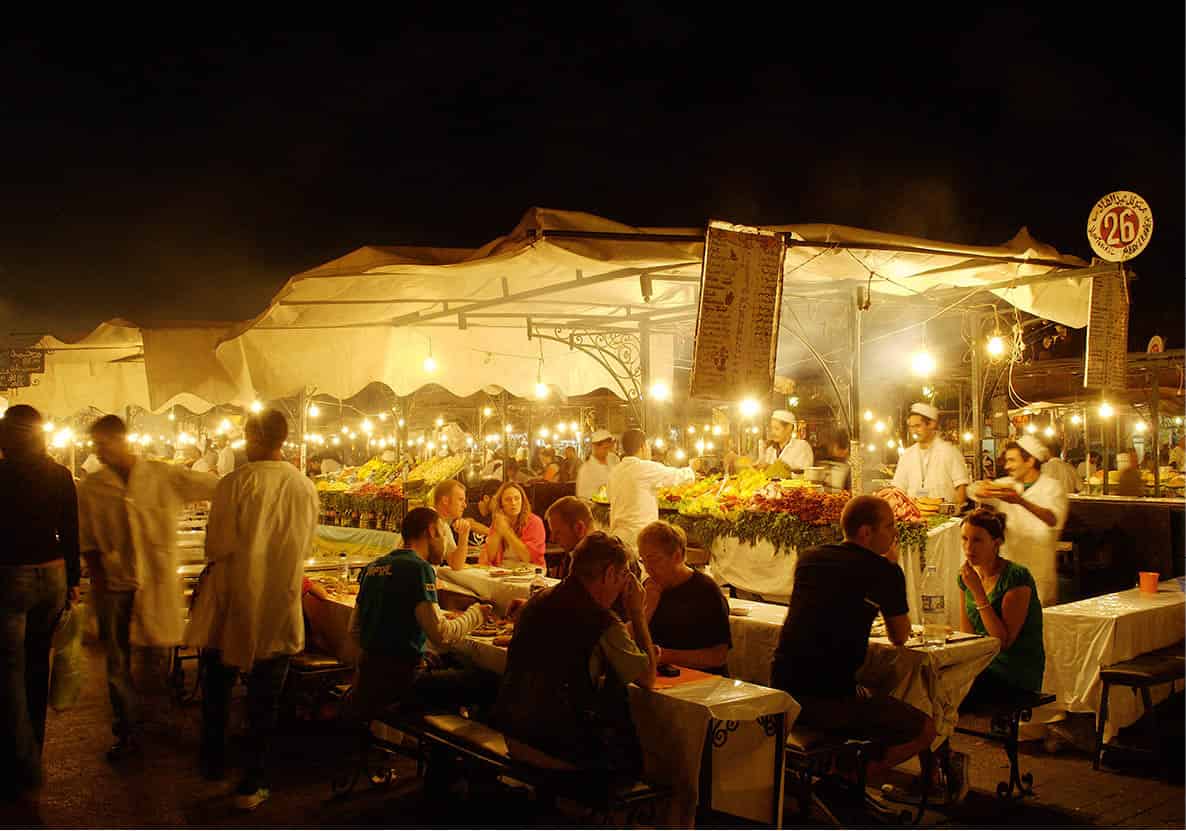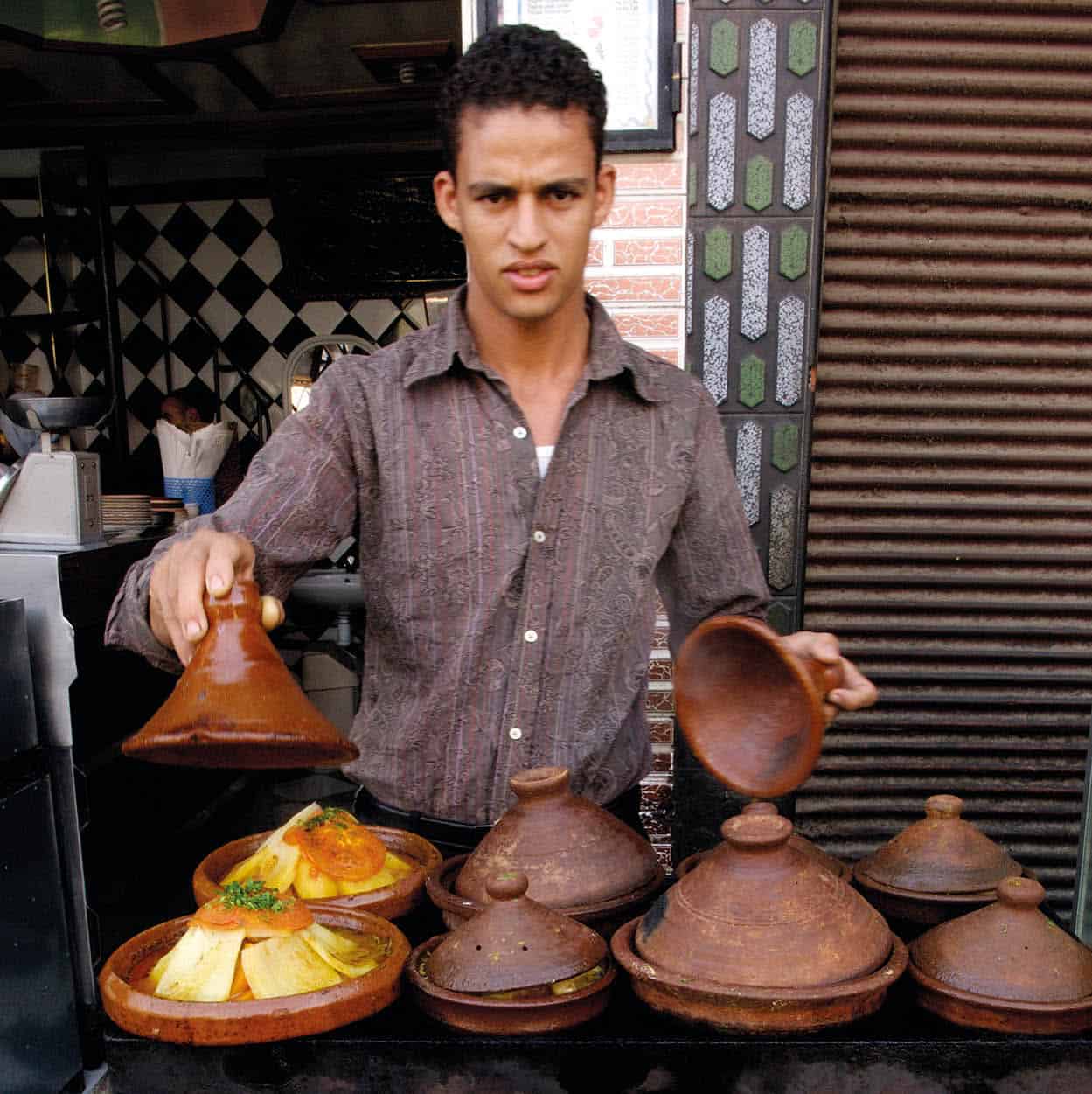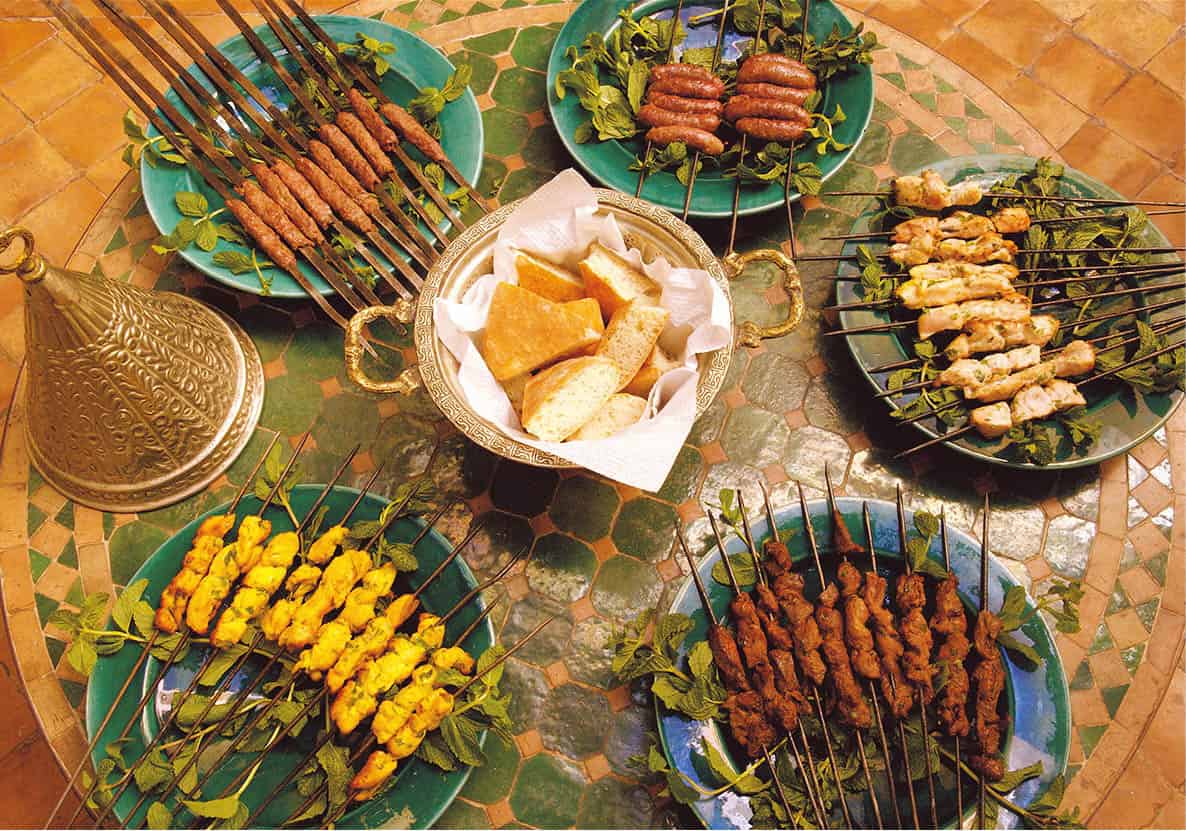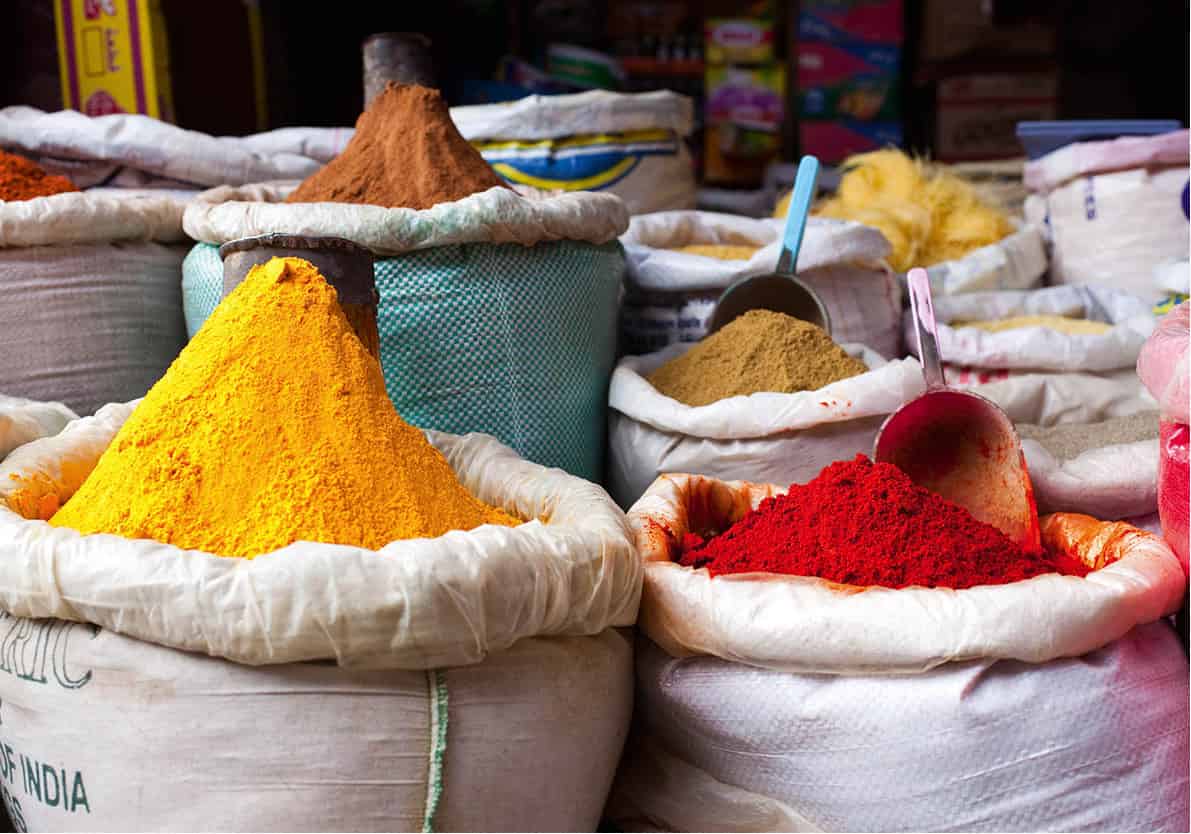The best Moroccan food is found in the home, where the art of cooking and intricate recipes are passed down through the generations. The average Moroccan will rarely eat ‘out’ except perhaps at one of the simple restaurants or food stalls found in every town. Traditional Moroccan dishes take hours to prepare, so in restaurants, the food is often prepared a long time in advance and reheated. Remember that many specialities, such as couscous, pastilla or mechoui (slow roasted lamb), need to be ordered 24 hours in advance. Be mindful to eat with your right hand.
Restaurants
In Marrakech, as everywhere else, the wise advice if you want to sample simple traditional food is to eat where local people eat. At the higher end of the price spectrum there are several wonderful places that reflect the rich range of Moroccan cooking itself, often producing modern twists on traditional dishes or creating huge feasts fit for a king – starting with a pastilla and ending, several courses later, with honey and nut encrusted halwa or exotically-spiced fruit. Several grand riads and palaces in the medina, like Dar Yacout, Dar Zellij and Dar Moha (for more information, click here), offer such gourmet set menus in magnificently exotic surroundings – usually in open courtyards under the stars, with luxurious seating and sometimes classical Moroccan music. The food is good, albeit expensive by Moroccan (and even international) standards and most people can only do it once – the majority find it hard to get beyond the third course. Failing an invitation to a private home, order dinner in your riad: this will be the closest you get to home cooking.
Almost every week another restaurant opens its doors in Guéliz and Hivernage, with a new concept, an even trendier setting and a more ‘fusioned’ menu. Consistency is a problem, as the restless crowds of Marrakchis and expats move from new place to newer, and the chefs come and go. It is no secret that restaurant and riad owners often snatch staff from their competitors while out for dinner. In recent years the selection of restaurants in the new town has become very cosmopolitan with every cuisine represented from the popular Mediterranean dishes to Italian, Indian, Thai and increasingly sought-after Japanese sushi and sashimi.
Time to eat
A growing number of local restaurants are open throughout the day, while some others stay open for lunch from noon–3pm, and again for dinner from 7.30 or 8pm to11pm. Most of the upmarket places need to be booked in advance.

Food stalls on the Jemaa el-Fna
Clay Perry/Apa Publications
Meal Times
Breakfast is usually served around 8 or 9am and is either a French-style meal of café au lait (milky coffee), baguette and croissant, or a delicious Moroccan-style spread with flat Moroccan bread (khubz), amlou (paste of crushed almonds with honey and argan oil), beghrir (a Moroccan pancake version of crumpets) with jam or honey, and freshly baked rghaif (flat buttery layered pastry). All usually come with freshly squeezed orange juice. Lunch is traditionally the most important meal in the day, and is eaten at any time between 1 and 4pm. Lunch usually means a selection of salads and vegetable dishes, followed by a main course of couscous, tagine or mechoui followed by a much needed mint tea, sweets and most probably a little nap. If you are in a hurry, there are plenty of faster options including brochettes, merguez (spiced sausages), sandwiches and quick-fix tagines. Dinner is eaten after sunset, from 8 or 9pm onwards. Most people eat a soup or lunch leftovers at home, but in Marrakech families head to the ‘Place’, Jemaa el-Fna, for a snack, while young people go out for a pizza or a bite with drinks in Guéliz.

Tagines, the traditional cookware
Clay Perry/Apa Publications

Moroccan kebabs (brochettes) are typically lamb, chicken or beef
Clay Perry/Apa Publications
Local Specialities
Among the many culinary delights Marrakech has to offer, don’t leave without sampling the following regional favourites.
Bread
Bread, either the French baguette or Moroccan flat bread, is eaten with every meal. It is always bought fresh from the local hanout or corner shop just before the meal. Often it is used instead of cutlery to scoop up vegetables or meat. Never take more bread than you need: Moroccans hold it in high regard as a ‘gift from God’, so it should never be wasted.
Ramadan
Most Moroccans don’t eat or drink from sunrise to sunset during the Holy Month of Ramadan. They break the fast with the meal called ftour, have dinner later in the evening, and eat breakfast before the sun comes up. Many restaurants close for the month or only open for ftour with a special Ramadan menu, but in hotels and the more touristic areas of Marrakech many places remain open all day. Tourists are not expected to fast, but they should eat and drink out of public view.
Couscous
Couscous is the national dish of Morocco, Algeria, Tunisia and Libya. The name comes from the Berber word seksou, and it consists of small grains of semolina.
In the West the fast-food pre-cooked version of couscous is most commonly found: you just need to add boiling water to the dry semolina and let it soak for a few minutes. In North Africa women make their own couscous by rolling two parts of semolina with one part of flour, some salted water and a little oil, until it is grain-sized. Once a batch is made it can be stored for a while. Couscous is steamed above a reduced broth of meat, vegetables and spices, with which it is then served. It can be served with fish, as in Essaouira, or with just vegetables.
Diffa
The diffa, or Moroccan feast in someone’s home or at a medina palace restaurant, consists of numerous courses. It starts with a selection of mezze or salads – between four and 10, mostly vegetables and dips eaten with bread, and briouates, tiny fried filo pastries stuffed with meat, cheese or spinach.
The traditional Moroccan soup is harira, made with lamb broth, tomatoes, chickpeas and lots of spices. It is a hearty soup often served with a few dates on the side. (In Ramadan, the month of fasting, harira and dates are served at sundown to break the fast). Instead of soup – or after it – there is often pastilla, a delicious ‘pie’ with layers of warka (fine filo pastry) and pigeon or chicken cooked with caramelised onion and toasted almonds, then dusted with icing sugar and cinnamon. The lighter version of pastilla comes with seafood instead of meat. The main course is couscous with meat and/or the traditional sept légumes (seven vegetables), a choice of tagines (meat, chicken or fish stews, often cooked with some sort of fruit) or a mechoui (slow roasted lamb or goat). The traditional mechoui, a whole lamb or kid slow roasted in a clay oven, is often served for special occasions, like weddings. Fish is delicious in Morocco but is not often on the menu in Marrakech, except in the more western restaurants of the new town.

Spices flavour the cuisine
Ming Tang-Evans/Apa Publications
Dessert
Dessert in Morocco is often fresh fruit, particularly melon, watermelon or slices of orange sprinkled with cinnamon, spices and orange flower water. Sweet pastilla au lait consists of layers of warka filled with a light orange blossom-flavoured crème anglaise or custard and nuts. Mint tea is served with a selection of sweet pastries made with almonds, nuts or honey. The finest is the Kaab el-ghzal or corne de gazelle (gazelle’s horn), a crusty pastry in a horn shape stuffed with almond paste perfumed with orange blossom. Shebbakia are fried pastries which are dipped in hot honey and sesame seeds, served during Ramadan.
Cookery classes
Many riad hotels organise cookery classes where you can accompany the house chef to the local market and learn how to cook traditional Moroccan food such as tagines, pastilla or couscous. Some of the best classes are available from Souk Cuisine (tel: 0673-80 49 55; www.soukcuisine.com), which organises culinary weeks in Marrakech; La Maison Arabe (tel: 0524- 38 70 10; www.lamaisonarabe.com); and Les Jardins de la Médina (tel: 0524-38 18 51; www.lesjardinsdelamedina.com).
Traditional Dishes
bessara a thick soup of fava beans, olive oil and spices.
couscous perhaps Morocco’s most famous dish. Of Berber origin, it is steamed semolina served with a broth of meat and vegetables – traditionally seven different ones.
harira rich lamb and chickpea soup eaten with dates.
loobia bean stew.
merguez hot spicy lamb sausages.
pastilla a multi-layered filo pastry with delicately sweetened pigeon.
ras el-hanout a mixture of 27 spices used on special occasions, particularly in stews.
tagine stew of meat or fish with fruit or vegetables, eaten with bread, cooked in the typical conical earthenware pot of the same name. One of the most traditional is tgjine mqalli: chicken with olives and preserved lemon. Another favourite is lamb with almonds and dates.
tanjia Festive Marrakchi dish of slow-cooked lamb stew in an urn-shaped earthenware crockpot, traditionally cooked for several hours in the embers of a hammam oven.
Mint and Chinese Gunpowder Tea
Moroccan mint (Mentha piperita), a fragrant kind of peppermint, is indigenous to Morocco. When in 1720 England’s King George I offered the Sultan of Morocco a box of Chinese green tea as a gift, it was considered too pungent and bitter to drink neat, so the Moroccans mixed it with the sugar and mint widely available in the local markets. These days the tea is still made with Gunpowder tea, an inexpensive Chinese green tea which was originally rolled to preserve its freshness for the long journey from China to Africa. Mint tea has become the national drink of Morocco, and according to the Moroccan trade ministry, the country is the major importer of Chinese green tea worldwide.
Drinks
Water and a variety of fizzy drinks are available everywhere, and are usually much cheaper than in Europe. In many places in Marrakech you can find delicious fresh juices; depending on the time of year they may include orange juice (plentiful on the Jemaa el-Fna), banana, avocado and carrot juice, and lait d’amande (almond milk). Make sure the juice is squeezed in front of you, and that the vendor doesn’t add tap water.
Alcohol is forbidden by the Qur’an, so in theory Muslims do not drink it, although a lot of Marrakchis do. Many traditional Moroccan restaurants (mainly in the medina, but excluding riad restaurants) don’t serve alcohol, but most of those (catering to tourists) in Guéliz and Hivernage do. The local beer is Flag, or the slightly more expensive, locally brewed Heineken and Casablanca, sold in beautiful bottles. In most tourist establishments foreign beers are also available. Since Roman times most of the local wines have been produced in Meknes, and plenty are very drinkable. The best reds are Volubilia, Médaillon, Domaine de Sahari, Guerrouane and Siroua. Good whites are Val d’Argan, Valpierre and Cuvée Président, while among the rosés the Sahari and Guerrouane are most recommended. The renowned French wine makers Châteauneuf du Pape are now producing a very good wine near Essaouira – the Val d’Argan red, rosé and white. For something typically Moroccan, mahia is a strong fig liqueur sometimes served as a digestif.
Moroccan coffee comes very strong and black; if you want it with milk ask for a noss noss or a café au lait. If you want milk with some coffee in it, ask for a café cassé. The most popular drink at any time of the day or night is thé à la menthe, or green tea with mint. Sometimes in winter the tea is served with chiba (absinthe) or fliou (menthol), and special guests are treated to mint tea with almonds or pine nuts.